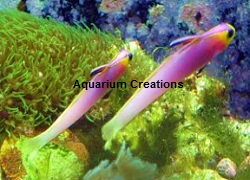Wild Collected, Aquarium Conditioned
Helfrichi Firefish
Nemateleotris helfrichi

Identification:
Helfrich's firefish are beautifully colored, peaceful toward other fishes, small enough to be easily housed in most aquariums, easy to feed, and not at all prone to disease. Firefish pose no threat to invertebrates and are thus ideal for reef aquariums. They are not completely without disadvantages, however. They are relatively shy and should ideally be kept with other fishes of similar temperament. If startled or chased by other fishes, they are likely to jump out of the aquarium so the aquarium should have a full cover.
Tank Recommendations:
e the best possible aquarium the Firefish requires a 20-gallon or larger system with moderate lighting conditions and a moderate current passing over the live rock "reef." When putting together a tank containing firefish, remember when stressed they will try to jump out of your aquarium. As such, house the Firefish in an aquarium system with a lid.
Food and diet:
Feed frozen crustaceans of suitable size, such as Artemia or copepods (i.e., red plankton), finely chopped mysis or krill, and fish roe are good staple foods. Flake foods will also be taken provided they are broken into small-enough pieces and preferably presented in midwater, as firefishes sometimes have difficulty learning to feed from the surface.
Level of Care:
Easy
Acclimaton Time:
1+ hours
Reef Compatibility:
Reef or Community Aquarium
Approximate Purchase Size:
Small: 3/4" to 1-1/4"; Medium: 1-1/4" to 2"; Large: 2" to 2-1/2"
|
Small $139.99
Medium $149.99
Large $169.99
|
|

